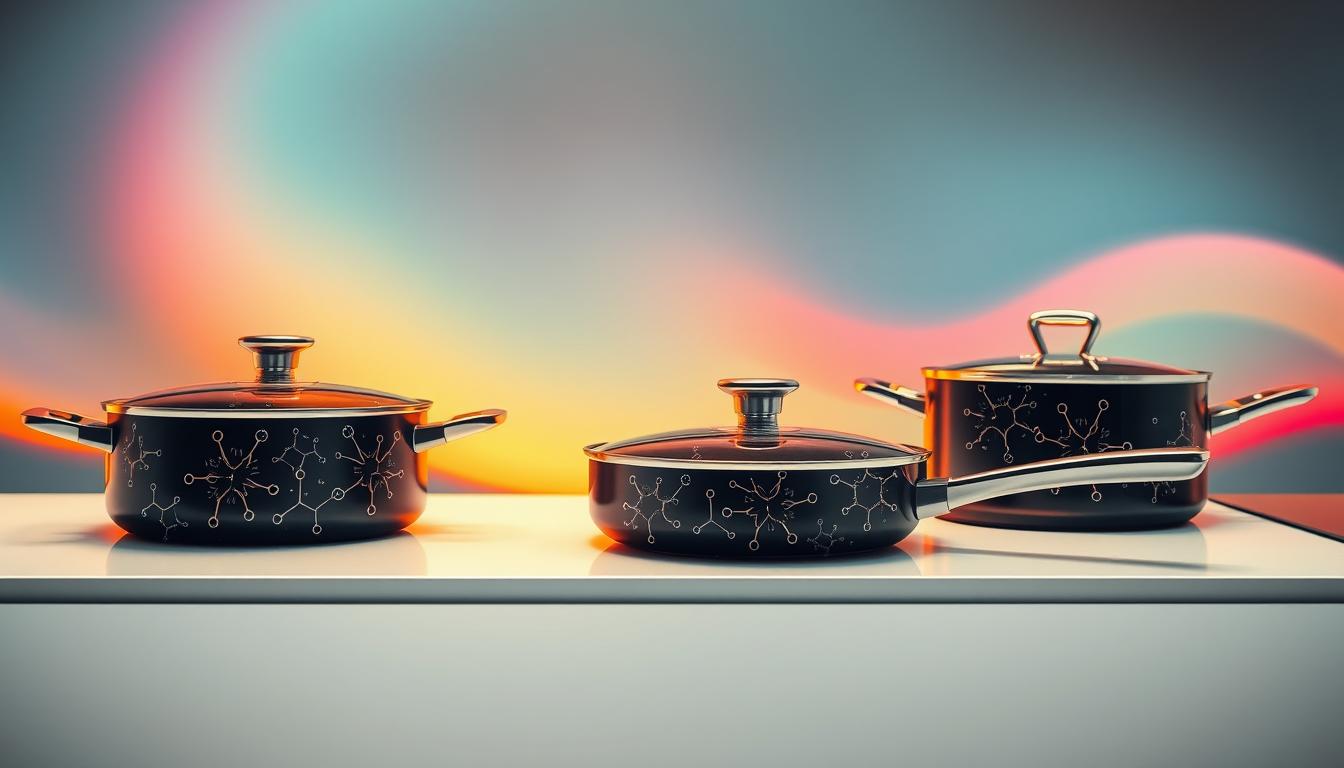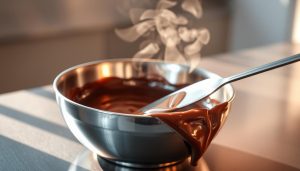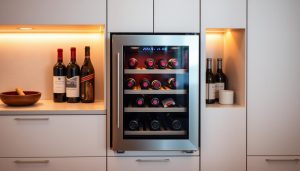Imagine owning cookware so slippery that even ants couldn’t climb it. That’s the reality of modern kitchens: 7 out of 10 skillets sold in the U.S. today use nonstick coatings, transforming how we cook. This revolution began with a lab accident in 1938, when chemist Roy Plunkett created PTFE while trying to develop a refrigerant. Instead, he invented the world’s slipperiest material—a discovery now etched in the Guinness World Records.
Nonstick surfaces work by minimizing friction at a molecular level. Their secret lies in tightly bonded carbon-fluorine chains, creating a smooth shield that repels food and oils. This hydrophobic property prevents sticking and reduces cleanup time by up to 90% compared to traditional pans. PTFE can handle temperatures from -328°F to 500°F, making it versatile for baking, frying, and freezing.
Why has this technology dominated kitchens? It simplifies cooking for beginners and experts alike. Eggs glide effortlessly, delicate fish fillets stay intact, and cleanup becomes a quick wipe. Innovations continue to refine these coatings, balancing durability with safety.
Key Takeaways
- Nonstick cookware accounts for 70% of skillet sales in the U.S.
- PTFE—the base material—was discovered accidentally in 1938 and holds a world record for slipperiness
- Molecular structure and hydrophobic properties prevent food from sticking
- Modern coatings withstand extreme heat and cold without degrading
- Nonstick surfaces reduce cooking oil use and simplify kitchen cleanup
A Closer Look at Nonstick Coatings
Ever wondered why pancakes flip perfectly in your favorite pan? The answer lies in precise engineering and chemistry. These nonstick coatings transform ordinary metal into slick cooking surfaces through a multi-step process.

How Nonstick Surfaces Work
At their core, these coatings create a barrier smoother than glass. Manufacturers sandblast metal pans to roughen them slightly. This helps the coating stick better. Then, they spray up to seven layers of PTFE—the key nonstick substance—onto the surface.
Thicker coatings last longer but cost more. Cheaper pans might have just one layer. High-end options use multiple layers for durability. The result? A surface so slick that food molecules can’t grip it.
| Coating Layers | Average Thickness | Typical Use Cases |
|---|---|---|
| 1-2 layers | 20-30 microns | Budget cookware |
| 3-5 layers | 40-60 microns | Mid-range pans |
| 6-7 layers | 70-100 microns | Professional kitchens |
Understanding the Role of Surface Chemistry
Two scientific principles make these coatings work. First, hydrophobic properties repel water and oils. Second, low surface energy prevents chemical bonds from forming. Together, they create a force field against sticky foods.
Carbon-fluorine chains in PTFE align tightly. This creates a dense molecular shield. When you cook eggs, their proteins literally slide off this shield. No scrubbing required—just a quick wipe cleans the pan.
Exploring The Science Behind Nonstick Surfaces
What do rocket ships and frying pans have in common? Both rely on PTFE—the miracle material discovered by accident. In 1938, DuPont chemist Roy Plunkett stumbled upon polytetrafluoroethylene while testing refrigerants. This white, waxy substance would later become Teflon®, rewriting kitchen history.

Teflon and the Discovery of PTFE
Plunkett’s failed experiment created the slipperiest material ever recorded. Teflon® debuted in 1946, turning pots into no-stick powerhouses. Its carbon-fluorine bonds formed an unbreakable chain—so durable it shields space shuttle components and waterproofs outdoor gear.
Molecular Secrets of Slipperiness
Every PTFE molecule resembles a carbon spine wrapped in fluorine armor. This structure creates three game-changing properties:
- Hydrophobic surface repels liquids like raindrops on a waxed car
- Friction coefficient lower than ice sliding on ice
- Chemical resistance surpassing most metals
| Property | Measurement | Real-World Impact |
|---|---|---|
| Friction Coefficient | 0.02 | Food slides off effortlessly |
| Thermal Stability | -328°F to 500°F | Safe for stovetop and oven use |
| Chemical Resistance | Withstands acids/bases | Ideal for lab equipment |
These traits explain why 83% of professional chefs keep nonstick pans in their arsenal. From delicate crepes to industrial wiring, PTFE’s versatility stems from its atomic blueprint.
Types of Nonstick Cookware and Their Applications
Your kitchen arsenal isn’t complete without understanding modern coating options. Today’s nonstick cookware ranges from eco-conscious ceramics to industrial-strength surfaces, each designed for specific cooking needs.

Ceramic Coatings: Eco-Friendly Alternatives
Ceramic-coated pans offer a guilt-free solution for health-conscious cooks. Made from baked silicon and oxygen, these PTFE-free surfaces withstand temperatures up to 600°F—perfect for searing meats or baking casseroles. Unlike traditional Teflon cookware, they eliminate concerns about chemical fumes during high-heat cooking.
“Ceramic coatings let me cook acidic foods like tomatoes without worrying about metallic tastes,” says New York chef Marco Vezzani.
Innovative Coatings: Diamond-Infused and Titanium-Reinforced
For heavy-duty performance, consider diamond-infused or titanium-reinforced options. Diamond particles create surfaces 3x harder than standard coatings, while titanium layers prevent scratches from metal utensils. These innovative coatings excel in professional kitchens where durability matters most.
| Coating Type | Key Feature | Best For |
|---|---|---|
| Ceramic | 600°F heat limit | Oven-to-table meals |
| Diamond-Infused | Enhanced conductivity | Even searing |
| Titanium-Reinforced | Scratch resistance | Daily family cooking |
Enamel-coated cast iron combines traditional heat retention with modern convenience. Unlike raw cast iron requiring seasoning, these pans provide instant nonstick performance while maintaining superior heat distribution.
Benefits and Challenges of Nonstick Technologies
How often do you reach for that trusty nonstick pan? These surfaces offer undeniable perks but require smart handling. Let’s break down their pros and cons.

Enhanced Cooking Efficiency and Easy Cleaning
Nonstick coatings let you cook eggs with minimal oil—sometimes none. Foods release smoothly, keeping delicate items intact. Cleanup becomes a 30-second wipe instead of scrubbing burnt residues.
Weeknight meals take less time and effort. A 2023 kitchen survey found users save 18 minutes daily on cleaning compared to stainless steel pans.
Temperature Sensitivity and Durability Issues
High heat ruins these surfaces. PTFE breaks down above 500°F—common during searing. A 2024 study advises keeping aluminum-based pans below 482°F for under 45 minutes.
Scratches from metal tools create entry points for microplastics. Once damaged, coatings lose their slickness and may flake into food.
Health and Safety Considerations
PFOA—used in early Teflon—was banned in 2015. Modern coatings avoid this chemical, but PFAS exposure remains debated. Recent research links it to thyroid issues and developmental concerns in infants.
Proper ventilation helps when cooking at medium heat. Avoid preheating empty pans, which can spike temperatures rapidly.
| Factor | Benefit | Challenge |
|---|---|---|
| Cooking Efficiency | 90% less oil needed | High-heat limitations |
| Maintenance | Quick cleaning | Scratch susceptibility |
| Health Impact | PFOA-free since 2015 | Ongoing PFAS research |
Best Practices for Use and Maintenance
Proper care transforms nonstick cookware from a short-lived tool to a kitchen workhorse. Follow these guidelines to preserve your pans’ slick surfaces and maximize their performance.
https://www.youtube.com/watch?v=p5XcN3AyITY
Proper Utensil Selection and Cleaning Techniques
Wood and silicone utensils protect coatings better than metal alternatives. Metal tools create microscopic scratches that degrade surfaces over time. For cleaning, use soft sponges with mild dish soap—harsh scrubbers strip away protective layers.
Always cool pans before washing. Sudden temperature changes warp surfaces. Store cookware with cloth separators between stacked pieces to prevent accidental scratches.
Temperature Guidelines and Lifespan Management
Never exceed 500°F—the point where coatings break down. Use oil or butter as visual alerts: their smoke points (350-450°F) signal when heat approaches dangerous levels. Preheat pans after adding fats to protect the surface.
Replace cookware when food sticks persistently or flakes appear. Most quality pans last 3-5 years with proper care. Rotate pans regularly to distribute wear evenly across your collection.
| Care Factor | Do’s | Don’ts |
|---|---|---|
| Utensils | Silicone spatulas | Metal forks |
| Cleaning | Cool water soak | Steel wool |
| Storage | Vertical hanging | Nested stacking |
Conclusion
Picture your morning eggs sliding effortlessly onto the plate—a daily convenience made possible by modern nonstick cookware. These kitchen tools balance innovation with practicality, offering quick cleanup and healthier cooking through reduced oil use. Research confirms their safety when handled properly: avoid metal utensils, monitor heat levels, and replace pans showing wear.
Today’s coatings outperform earlier versions. PFOA-free formulas address past health concerns, while reinforced surfaces withstand temperatures up to 500°F. Yet durability depends on care. Use silicone tools for flipping food, and store pans separately to prevent scratches.
Your kitchen benefits most when matching cookware to needs. Ceramic options suit oven-to-table meals, while diamond-infused pans excel at searing. Regardless of type, proper maintenance extends lifespan—most quality pieces last 3-5 years with attentive use.
Ultimately, nonstick technology simplifies home cooking without compromising safety. By following guidelines and choosing reputable brands, you maintain both meal quality and peace of mind. Upgrade when coatings degrade, and enjoy friction-free prep for years to come.



